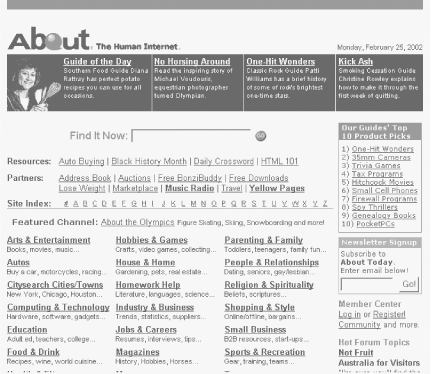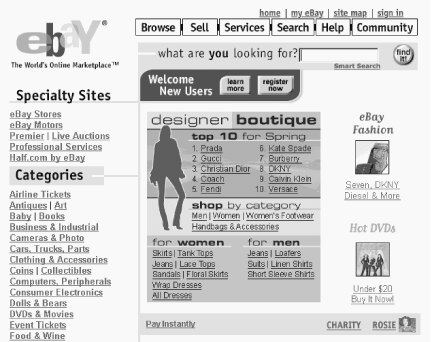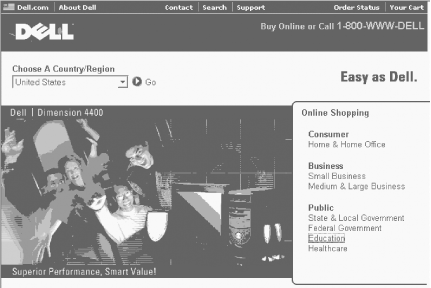WebReference.com - Part 1 of chapter 5 from Information Architecture for the World Wide Web, 2nd Edition. From O'Reilly (7/8).
[previous] [next] |
Information Architecture for the WWW, 2E. Chapter 5: Organization Systems
Topic
Organizing information by subject or topic is one of the most useful and challenging approaches. Phone book yellow pages are organized topically, so that's the place to look when you need a plumber. Academic courses and departments, newspapers, and the chapters of most nonfiction books are all organized along topical lines.
While few web sites are organized solely by topic, most should provide some sort of topical access to content. In designing a topical organization scheme, it is important to define the breadth of coverage. Some schemes, such as those found in an encyclopedia, cover the entire breadth of human knowledge. Research-oriented web sites such as About.com (shown in Figure 5-5) rely heavily on their topical organization scheme. Others, such as corporate web sites, are limited in breadth, covering only those topics directly related to that company's products and services. In designing a topical organization scheme, keep in mind that you are defining the universe of content (both present and future) that users will expect to find within that area of the web site.

Figure 5-5: This site provides a topical taxonomy and an alphabetical site index
Task
Task-oriented schemes organize content and applications into a collection of processes, functions, or tasks. These schemes are appropriate when it's possible to anticipate a limited number of high-priority tasks that users will want to perform. Desktop software applications such as word processors and spreadsheets provide familiar examples. Collections of individual actions are organized under task-oriented menus such as Edit, Insert, and Format.
On the Web, task-oriented organization schemes are most common in the context of e-commerce web sites where customer interaction takes center stage. Intranets and extranets also lend themselves well to a task orientation, since they tend to integrate powerful applications or "e-services" as well as content.
You will rarely find a web site organized solely by task. Instead, task-oriented schemes are usually embedded within specific subsites or integrated into hybrid task/topic navigation systems, as we see in Figure 5-6.

Figure 5-6: Browse, Sell, Search, and Sign In are explicitly labeled on the main page
Audience
In cases where there are two or more clearly definable audiences for a web site or intranet, an audience-specific organization scheme may make sense. This type of scheme works best when the site is frequented by repeat visitors who can bookmark their particular section of the site. It also works well if there is value in customizing the content for each audience. Audience-oriented schemes break a site into smaller, audience-specific mini-sites, thereby allowing for clutter-free pages that present only the options of interest to that particular audience. The main page of dell.com, shown in Figure 5-7, features an audience-oriented organization scheme (on the right) that invites customers to self-identify.

Figure 5-7: Dell invites users to self-identify
Organizing by audience brings all the promise and peril associated with any form of personalization. For example, Dell understands a great deal about its audience segments and brings this knowledge to bear on its web site. If I visit the site and identify myself as a member of the "Home & Home Office" audience, Dell will present me with a set of options and sample system configurations designed to meet my needs. In this instance, Dell makes the educated guess that I probably need a modem to connect to the Internet from my home. However, this guess is wrong, since I now have affordable broadband access in my community. I need an Ethernet card instead. All ambiguous schemes require the information architect to make these educated guesses and revisit them over time.
Audience-specific schemes can be open or closed. An open scheme will allow members of one audience to access the content intended for other audiences. A closed scheme will prevent members from moving between audience-specific sections. This may be appropriate if subscription fees or security issues are involved.
[previous] [next] |
Created: September 23, 2002
Revised: September 23, 2002
URL: https://webreference.com/authoring/design/information/iawww/chap5/1/7.html


 Find a programming school near you
Find a programming school near you